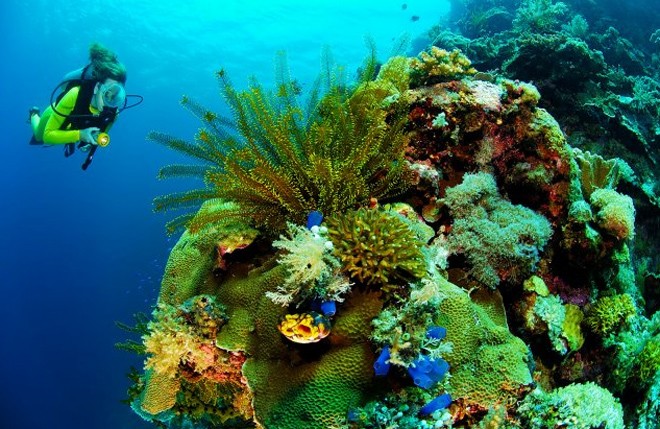Hurricanes, cyclones, typhoons - the underwater damage
by Jessica Wurzbacher, MSc/Sail-World on 8 Oct 2011

SFS Coral polyps with tentacles - vulnerable SW
Whether you experience typhoons, cyclones or hurricanes in your part of the world, they all cause major destruction, loss of life and devastation to many. It is extremely likely that you know the devastating impacts these natural phenomena can have on coastal communities, but what goes on beneath the waves as the thunderous beasts unleash on the shore line? Jessica Wurzbacher has written for Sailors for the Sea about this subject:
Such severe storm events have an impact on the invertebrate marine life (coral reefs) as well as the vertebrates, on ocean pollution, the underwater coastlines and on the sea temperatures:
The impacts of hurricanes on invertebrate marine life (e.g. coral reefs):
Coral reefs are fragile biological structures, composed of the calcium carbonate skeletal remains of many generations of coral polyps. Corals species grow in different shapes and sizes and dominate in different areas of the reef (Figure 1).
The branching corals (e.g. Acropora spp.) are the most susceptible to wave damage, but are often found in shallow areas as they are able to use this fragmentation as a method of dispersal. These corals can reattach if they settle on a suitable substrate, and they have a relatively fast rate of growth (~20cm/yr).
Hurricanes can have a devastating impact on coral reefs crushing these delicate structures. (see the last scene of BBC's Blue Planet: Coral Seas). The waves can also propel rubble, and other debris (e.g. artificial reefs not securely anchored) onto the small coral polyps crushing and killing them.
The wave action also increases turbidity and sedimentation, this lowers light penetration to the photosynthetic algae in the coral's tissues, and also directly kills the coral through smothering as the substrate particles clog cilia on their tentacles. The heavy rainfall associated with hurricanes alters the salinity of the water, which is an additional stress for the fragile marine life (Morton, 2002).
The impacts of hurricanes on vertebrate marine life:
Many invertebrate are affected by the increased wave action associated with hurricanes, e.g. breakage of hard coral, sponges, seafans, seawhips, etc, but in general, large vertebrate are minimally affected. Many organism can sense the impending weather system and show great escape tactics. Fish are able to detect waves of pressure or mechanical disturbances in the water through neuromasts in their lateral line. Blacktip reef sharks (Carcharhinus limbatus) were recorded responding to the drop in barometric pressure as Tropical Storm Gabrielle approached, and fled into deeper water ahead of the storm.
The resulting pollution from hurricanes:
29th August, 2005 Hurricane Katrina made land fall in Buras, LA, the destruction was immense. By 9th September 2005 NOAA and the Environmental Protection Agency (EPA) had been notified of 200 hazardous materials released and more than 70 salvage problems with a pollution threat (Pine, 2006). In addition, 46 offshore oil platforms were destroyed, a further 20 were damaged and nearly 50 oil spills were reported in the near-shore environments (Figure 4) (Pine, 2006).
The impacts of hurricanes on the coastline:
Hurricanes can cause significant coastal erosion in a short amount of time, exacerbated by the elevated sea levels association with the storm surge. The powerful force of the waves can easily move large amounts of sand, for example Ocracoke Island, NC suffered severe coastal erosion following Hurricane Irene last month.
The impacts of hurricanes on sea temperatures:
By the end of the summer the nutrients in the surface water have been depleted by the photosyntheticphytoplankton, productivity is low. A strong hurricane will cause ocean mixing, bringing up cooler deeper water to the surface. This deeper water is rich in nutrients, and coupled with the late summer sunlight it generates a large plankton bloom (Figure 6). It is too premature to conclude that human activity (particularly global warming) has had a detectable impact on the Atlantic hurricanes. Model simulations indicate that the 21st century warming may lead to a larger number of intense hurricanes and higher hurricane rainfall rates, but fewer hurricanes overall (NOAA).
For the full essay http://sailorsforthesea.org/Sailing-and-The-Environment/Ocean-Watch/Ocean-Watch-Essays/The-Impacts-of-Hurricanes-Underwater.aspx!click_here, and to learn more about Sailors for the Sea, http://sailorsforthesea.org!click_here.
If you want to link to this article then please use this URL: www.sail-world.com/89384